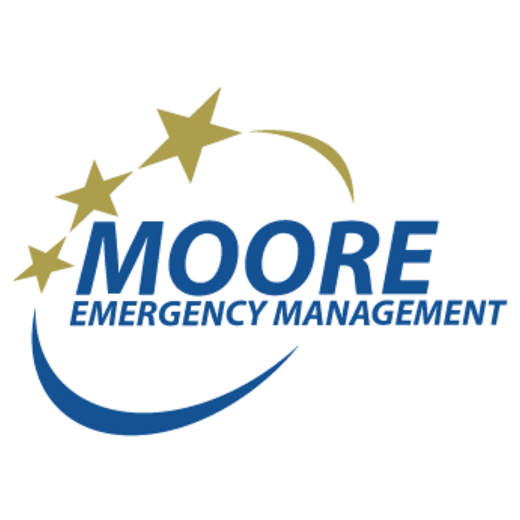Emergency Preparedness & Resources
The weather in Moore is normally delightful – BUT – we do occasionally witness the power and ferocity of severe thunderstorms. What should you do when severe weather threatens, what shouldn’t you do, and what do our authorities do.
Weather Threats Thunderstorms can threaten your personal safety in a number of different means. The primary weather threats, ranked by number of fatalities annually, are:
- Flash Flooding;
- Lightning;
- Tornadoes;
- Straight-line winds;
- Hail
It is also useful to know the physical threats that occur during a tornado and severe straight-line wind events. These include (from most likely to least likely):
- Being penetrated by flying debris propelled by winds, which can be in excess of 100 mph;
- Being crushed under something heavy;
- Being lifted and thrown by the wind
Watches and Warnings
These factors are why it is important to cover yourself with a heavy coat or blanket (in an attempt to stop/slow the debris), and to take shelter under something sturdy, such as a heavy desk.
Weather WATCH
A WATCH is issued when expert convective storm meteorologists at the Storms Prediction Center in Norman determine that severe thunderstorms or tornadoes are possible. These watches are generally issued for large areas, such as all of western Oklahoma. A WATCH means to continue normal activities, but to keep an eye to the sky. As with the warnings as listed below, severe weather watches are issued for potential tornado, severe thunderstorm, and flash flood events.
Weather WARNING
A WARNING is issued by meteorologists at local weather service offices when severe weather or tornadoes are actually occurring. Warnings are generally issued for very small areas, such as a single county or groups of 2-3 counties. When a WARNING is issued, you should TAKE COVER IMMEDIATELY if you are in the path of the storm! Three types of WARNINGS are issued for severe storms: TORNADO WARNINGS, when tornado conditions have actually been observed or are imminent based upon radar information; SEVERE THUNDERSTORM WARNINGS, where storms are producing straight line winds of 57 mph or greater, hail 1” diameter or greater, and/or are capable of producing a tornado; FLASH FLOOD WARNINGS, where streams, creeks, or urban waterways are flooding or will be very soon. In Moore, our Emergency Management staff works closely with the meteorologists at the National Weather Service Forecast Office located in Norman. NWS personnel will generate warnings based upon not only radar information, but also information from our Moore severe weather spotters that are in the field. Therefore, when a warning is issued for Cleveland County, our EOC staff normally have played a part in the decision process. If our EOC staff determine that tornadic conditions will directly affect Moore, we will activate our local warning system, consisting of an outdoor warning siren system and a cable television interrupt. The NWS office will be triggering the alarm on NOAA Weather Radio, and local media will be broadcasting the warning as well.
Things Not to Do
During severe weather warnings, there are a few things NOT to do: First, don’t go outside or to a window to look around. Instead, take shelter immediately and gather information on the storms via a portable battery powered NOAA Weather Radio, commercial broadcast radio or television. Don’t call 9-1-1 or the Police/Fire Departments for information on the storms or where to shelter. Know ahead of time where to take shelter, and as noted above, get information on the weather via radio or TV. 9-1-1 should never be called unless you have an emergency, and our Communications, Emergency Management, Police, and Fire personnel are typically extremely busy during severe weather events. Don’t take a shower or bath, use a regular wireline telephone, or use a computer connected to a modem. Should lightning strike nearby, the electrical current could travel through the telephone line or the plumbing to you. Finally, don’t take shelter under a highway bridge. Click on the next page for more information on this.
Tornado Safety
Tornadoes are the most violent atmospheric phenomenon on the planet. Winds of 200-300 mph can occur with the most violent tornadoes. If a tornado was approaching, would you know what to do? The following are instructions on what to do when a tornado warning has been issued for your area or whenever a tornado threatens.
- If an shelter or safe room engineered for storm refuge is available, go there!
- In homes or small buildings, go to an interior room on the lowest floor, such as a closet or bathroom. Wrap yourself in overcoats or blankets to protect yourself from flying debris.
- All public schools and both hospitals in Moore have engineered shelters for their students/patients and staff. They are *not* shelters for the general public.
- In shopping centers and commercial buildings, go to interior rooms and halls on the lowest floor. Stay away from glass enclosed places or areas with wide-span roofs such as warehouses. Crouch down and cover your head.
- Vehicles are NOT the place to be!! Most tornado deaths occur in cars and mobile homes. If you are in either of those locations, leave them as soon as possible and go to a substantial structure or designated tornado shelter. If in your car, remember that highway bridges are not designed as tornado shelters, and make for very poor shelter.
- If no suitable structure is nearby, lie flat in the nearest ditch or depression and use your hands to cover your head.
Actual tornadoes – on the ground, causing damage – do NOT occur as frequently in Moore as one might think. According to the National Weather Service storm database for Cleveland County, about a dozen tornadoes have struck Moore or the immediate area in the past 50 years. Of these, four have been significant in terms of destruction and fatalities.
- November 19, 1973, F3 tornado: Two fatalities occurred in a mobile home park in the southwestern part of Moore. The shopping center near NW 5th & City Ave was damaged, and the roof was removed from the northeast part of Northmoore Elementary School
- May 3, 1999, F5 tornado: An extremely violent tornado devastated a path from Chickasha, Bridge Creek, and southwest Oklahoma City. The tornado entered Moore in the Greenbriar Eastlake addition, crossed I-35 at Shields Blvd., tracked through the Highland Park addition, and continued into Oklahoma City and Del City before dissipating near I-40 in Midwest City. Five fatalities occurred in Moore, including one from a person sheltering under the Shields overpass on I-35. More than 750 homes were destroyed or sustained major damage, as well as over 200 apartment units.
- May 8, 2003, EF-4 tornado: This tornado first touched a block west of the Moore city limits and travelled northeast through the Southgate addition, crossed I-35 in the area of NE 18th St., and continued through the southern portion of the Highland Park addition. There were NO fatalities and only a few reported injuries in Moore from this storm! More than 800 homes and 300 apartment units were destroyed or suffered major damage in this event.
- May 20, 2013, EF-5 tornado: Another extremely violent EF-5 tornado struck Moore. The storm crossed the South Canadian River near Newcastle, tracked through southwest Oklahoma City, and destroyed Briarwood Elementary School. The storm entered Moore near SW 16th & Santa Fe and tracked northeast through the Plaza Towers and Kings Manor additions. It changed direction at SW 4th & Telephone Road and began to move more southeasterly/easterly, destroying Moore Medical Center and businesses along I-35. The storm moved east and dissipated just east of Moore. 25 fatalities occurred during this event, 21 of which were in the city limits of Moore. Of these, 10 were sheltering in their homes; 7 were students sheltering at Plaza Towers Elementary School, 3 were in a walk-in cooler at the convenience store at SW 4th & Telephone; and 1 was sheltering in his business. More than 1100 homes were destroyed and another 1200 affected; around 45 mobile homes destroyed/damaged and another 100 affected; and 80 apartment units destroyed/damaged.
Lightning Safety
Do you know what to do if you are caught in the open during a thunderstorm or you feel tingling or your hair standing on end? Lightning can strike up to several miles away from the thunderstorm. When inside:
Avoid using the telephone (except for emergencies) or other electrical appliances.
Do not take a bath or shower.
If caught outdoors:
Go to a safe shelter, such as inside a sturdy building, immediately! A pickup truck or hard top automobile with the windows up can also offer fair protection. Most open park shelters and pavilions do NOT offer good protection.
If you are boating or swimming, get out of the water immediately and move to a safe shelter away from the water!
If you are in a wooded area, seek shelter under a thick growth of relatively small trees.
If you feel your hair standing on end, squat with your head between your knees. Do not lie flat!
Avoid isolated trees or other tall objects, bodies of water, sheds, fences, convertible automobiles, tractors and motorcycles.
Flash Flood Safety
Flash floods develop quickly.
They can occur anywhere, along rivers or creeks, in low water crossings or in a dry stream bed. They can occur during any month and at any time during the day. In fact, flash floods often occur at night when it is difficult to find an escape route. Flash floods can be deceptive. Flood waters are likely deeper and moving faster than you think.
WHEN DRIVING
- Avoid low water crossings.
- Use alternate routes to avoid flood prone areas.
- Leave your vehicle immediately if it stalls in flood waters.
- Move to higher ground if you can do so safely.
- Most cars and light trucks will begin to float in as little as 1 to 2 feet of water.
ACT QUICKLY
Rising waters make vehicle doors difficult if not impossible to open.
IF YOU ARE OUTSIDE
Everyone, especially children, should stay away from flooded creeks, streams or drainage ditches.
Swiftly flowing water can quickly sweep away even the strongest swimmers.
Soggy banks can collapse, dumping you into flood waters. Flash Floods develop quickly.
They can occur anywhere, along rivers or creeks, in low water crossings or in a dry stream bed.
They can occur during any month and at any time during the day. In fact, flash floods often occur at night when it is difficult to find an escape route.
Flash floods can be deceptive. Flood waters are likely deeper and moving faster than you think.

